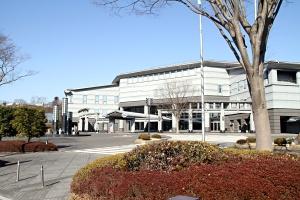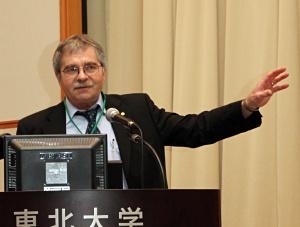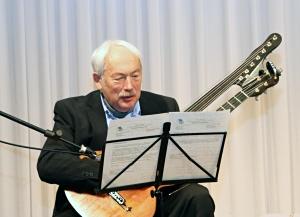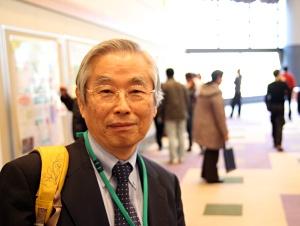

04/25/2011
The WPI-AIMR Annual Workshop, held this year on 21–24 February in Sendai, Japan, amid brilliant late winter sunshine, is a central part of academic life at the WPI-AIMR, providing a forum for members of the institute to meet as a body with other top-level researchers from around the world to discuss the state-of-the art in materials science, establish research contacts and plan for the future.
In 2011, the workshop — the fourth since the establishment of the WPI-AIMR at Tohoku University — was convened at the Sendai International Center under the banner of ‘Cutting-edge Functional Materials for Green Innovation’, drawing more than 220 participants from 41 organizations in 10 countries, including many senior and internationally renowned materials scientists from the Asia-Pacific, Europe and North America.

Speaking to AIMResearch on the eve of the workshop, WPI-AIMR director Yoshinori Yamamoto looked forward to a lively and constructive meeting and outlined his plans for the forward development of the institute, including the further development of links with leading international institutions such as the University of Cambridge in the UK and advancing the agenda of green innovation at the WPI-AIMR. Yamamoto maintained this theme in his welcoming address to the workshop participants, recalling the progress made by the institute’s researchers in further developing fusion research and placing green innovation squarely at the heart of the work of the institute.
“There is no doubt that creating new functional materials for green innovation leading to the development of green materials needs the approach of fusion research,” he said. Following this, in his opening remarks Tohoku University president Akihisa Inoue congratulated the WPI-AIMR on their “tremendous efforts in advancing fusion research to create new research disciplines” and noted the importance in this endeavor of the network developed between the WPI-AIMR and its 22 partner institutions, which includes three satellite centers located around the world. This international outlook is manifested by the large number of non-Japanese researchers at the WPI-AIMR — just over half of the current total of 128 come from outside of Japan.
Inoue also spoke of his high expectations for the key part that the WPI-AIMR will play in realizing his eponymous development plan for Tohoku University, which he introduced in 2007. Describing the institute as a “locomotive for reinforcing the research foundations of Tohoku University as a research-intensive university,” Inoue praised the WPI-AIMR strategy of developing green innovation for the benefit of society, calling the initiative “timely.” This message was reinforced by Toshio Kuroki, the WPI program director, in his welcoming address to the conference, calling upon the WPI-AIMR to become “a frontrunner for materials science research by creating new materials for a future society.”

Following the opening session, the academic program of the conference commenced with a special first session composed of three lectures on a diverse series of cutting-edge topics delivered by a trio of particularly highly acclaimed materials science researchers. In the first of these, Georg Bednorz from IBM Research Zürich, who shared the 1987 Nobel Prize in Physics, addressed the conference on the latest developments in superconductivity. Bednorz noted that 2011 is the 100th anniversary of the discovery of the phenomenon of superconductivity, and went on to describe recent developments in high-temperature superconductivity, an area that has witnessed a dramatic rise in importance in the last quarter century to the point that it has now become a key technology for ensuring reliable, environmentally friendly and efficient energy use.

A neat counterpoint to the opening lecture was given by the 2007 Physics Nobel Laureate Peter Grünberg from the Jülich Research Centre in Germany, who spoke on the use of giant magnetoresistance and its potential to address problems of world energy. This was the second contribution made by Grünberg, who had earlier entertained participants as part of a musical ensemble that played a selection of Japanese and Austrian folk melodies at the pre-conference wine mixer on the previous night. The special session was rounded off by carbon nanotube pioneer Sumio Iijima, Professor of Meijo University as well as WPI-AIMR adjunct Professor, who reported on the current state-of-the-art in the industrial production and applications of carbon nanotubes and graphene. The theme of the closing lecture was on one of the most pressing issues in materials science research and took on even greater significance in the context of the awarding of the 2010 Nobel Prize in Physics for pioneering work in the field of graphene research.

In addition to the special session, the academic program also boasted 20 plenary lectures given by leading international materials scientists, including members of WPI-AIMR overseas satellite centers, as well as other presentations delivered in six parallel sessions. As in previous years, the lecture program was supplemented by a poster session that drew over 80 contributions on a wide variety of topics over the first two days of the meeting. The research presented during the three days of the 4th WPI-AIMR Annual Workshop encompassed a diverse range of topics including bulk metallic glasses, materials physics, soft materials and device/system construction. In so doing it reflected the wide-ranging research remit of the center and further reinforced the workshop as a key event in the annual WPI-AIMR calendar.